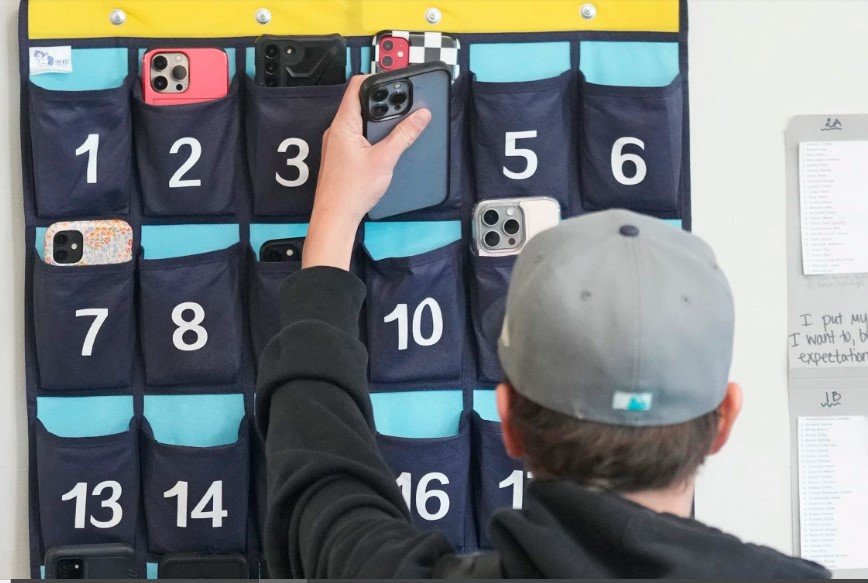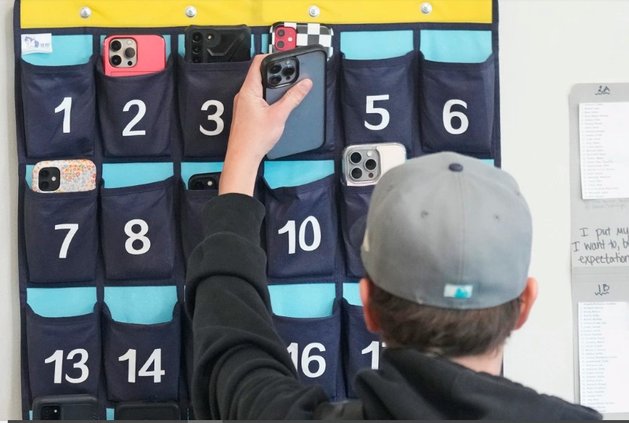California taxpayers spend in excess of $20,000 year to educate a student in kindergarten through 12th grade.
That’s according to the California Policy Center that takes the kitchen sink approach to calculating the cost of a public education.
The center just doesn’t factor in ongoing costs associated with teaching students.
The figure reflects other costs not factored into the state’s average daily attendance funding such as paying for school bonds.
In any case, it’s a lot of money.
It is why the off-the-cuff reaction by the California School Boards Association to Gov. Gavin Newsom’s pronouncement that the state needs to restrict student smartphone access in schools was disappointing, to say the least.
The organization run by a healthy number of former school administrators that represent the interests of member school boards essentially said Sacramento should butt out.
The CSBA believes any student smartphone policy put in place is a local school board issue, and not the state’s concern.
Given how there is mounting evidence excessive smartphone use by students is creating what experts aptly describe as a mental health pandemic should make the need to regulate how schools handle them as if it were a highly transmittable disease a state concern.
And that’s what Newsom is implying.
But shouldn’t the real issue be how we are not effectively spending limited resources on educating students?
That goes not just for individual student outcomes but also from the perspective it is morally corrupt to allow practices that waste taxpayers’ financial investments on a wholesale basis.
Much ado has been made about the powerful possibilities of devices such as smartphones to educate students.
That sentiment has led to the somewhat blind embracing of tech devices often without addressing and standing firm against its detrimental drawbacks
In doing so, we are rendering a proven education “device” to become more and more marginally effective while more school time is spent with eyes on smartphones.
Those education “devices” are what we call teachers.
There has yet, and likely never will be, a civilized advancement to impart knowledge, reasoning, and their various intellectual cousins on the multi-faceted levels trained teachers can provide.
Technology should build on teachers — not replace them or make them a distraction.
Technology shouldn’t undermine teachers.
Yet, that is exactly what smartphones are being allowed to do.
And that’s on top of putting school bullies on steroids and giving them the anonymity of social media that they are allowed to use during school time by having access to smartphones from the morning bell to dismissal.
Note passing is not allowed in classrooms.
Nor is a student allowed to read a comic book while a teacher is instructing.
The CSBA holds the position apparently that the tech versions of both note passing and comic book reading are something that local schools and not the state should regulate.
Then why are the modern day versions of note passing and comic book reading so prevalent that the governor of California has decided to intervene?
The truth is societal pressures create landmines for school administrators and school boards — let alone teachers — if they try to do so.
How many educators believe it makes sense for teachers during class time to compete with smartphones?
It’s doubtful that many, or any, do.
There isn’t any strong evidence, anecdotal or otherwise, that students do not access smartphones in class.
What is the harm in sneaking a peak at a video while teachers are instructing?
Would that question even be asked if students replaced a smartphone with a mini-TV set to watch a Netflix show while teachers were trying to explain a math problem?
If you think that is absurd, consider this: Watching TV and watching a smartphone video are cut from the same cloth although the technology is different with one clearly being less cumbersome.
The bottom line, though, is the same.
Students are watching something for entertainment instead of learning.
And if they are texting, they are really just replacing low-tech paper and pencil used to pass notes with a smartphone keyboard.
The fact Newsom can even suggest the state should move to restrict student smartphone access in the classroom without a collective “huh” reverberating through the halls of the State Capitol is confirmation that school districts might be wary to do so on their own.
A uniform approach based on the need to not squander expensive and limited classroom time where students can “interface” with a teacher removes a barrier to accessing an education.
Experts call for smaller class sizes but why bother if local districts refuse to risk the wrath of parents who on one hand hammer schools for not teaching their kids and then pushback on restricting smartphone use in classrooms.
We expect schools to educate.
And we expect them to provide a safe and distraction free environment to do so.
By having phones being readily accessible to a student in a classroom setting undermines such objectives.
The fact that two polar opposites on the cultural war spectrum — Newsom who might just be the nation’s bluest governor and Florida’s Ron DeSantis who is redder than red — agree it is a problem is a sure sign smartphones have become a serious education issue.
And judging by the growing rumblings, smartphones have become a serious public health issue among the school-aged.
Consider the following: “As the Surgeon General affirmed, social media is harming the mental health of our youth . . . When children and teens are in school, they should be focused on their studies — not their screens.”
Those are not words of someone painted as an alarmist or whose political agenda for accepted school norms are rooted in the late 1950s.
They were uttered by Newsom in making his pitch to regain ground the smartphone has captured in California’s schools.
This column is the opinion of editor, Dennis Wyatt, and does not necessarily represent the opinions of The Bulletin or 209 Multimedia. He can be reached at dwyatt@mantecabulletin.com






